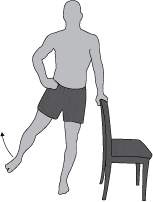

We therefore used gait initiation as our standard task. In normal subjects, EMG activity in the task of interest may be expressed as a percentage of activity in a maximum voluntary contraction, but this is impractical in hemiparetic patients. We have used this technique to compare the postural responses of hemiparetic muscles and compensatory activity in contralateral muscles.Ībsolute amplitude of EMG activity in different normal muscles may vary widely, making direct comparison of results from one subject to another less reliable. 4 5 By applying identical sideways forces in each direction, the responses of the hemiparetic and unaffected side of the body may be compared. 1 Patients with hemiparetic stroke show either a delay in onset of the normal ordered pattern of distal to proximal activation of agonist muscles, or the sequence of activation is replaced by cocontraction of agonist and antagonists.

Induced forward sway in normal subjects elicits a pattern of distal to proximal muscle activation of the gastrocnemius muscle, hamstrings, and paraspinal muscles with latencies ranging from 80–120 ms. This can lead to difficulty walking and increased risk of falling. Stroke commonly disrupts the automatic postural responses which contribute to standing balance. This suggests that hemiparetic patients should be able to step before regaining standing balance. By contrast, the pattern and peak amplitude of hip muscle activation in stepping was normal in both hemiparetic and non-hemiparetic muscles of the subjects with stroke.ĬONCLUSIONS In ambulant patients with stroke, a normal pattern of activation of hemiparetic muscles is seen in stepping whereas the response of these muscles to a perturbation while standing remains grossly impaired and is compensated by increased activity of the contralateral muscles. During self initiated sideways weight shifts at gait initiation, hemiplegic muscle activation was impaired. Contralateral, non-paretic, adductor activity was increased after a push towards the hemiparetic side of patients with stroke and the latency was normal (110 ms). In hemiparetic patients, the amplitude of activity was reduced in the hemiparetic muscles, the onset latencies of which were delayed (gluteus medius 96 ms, adductor 144 ms). RESULTS In the standing balance task, normal subjects resisted a sideways push to the left with the left gluteus medius (74 ms) and with the right adductor (111 ms), and vice versa. Similar recordings were made in the same subjects during gait initiation and a single stride. Amplitude and onset latency of surface EMG activity in hip abductors and adductors were recorded in response to sideways pushes in either direction while standing. Median interval between stroke and testing was 17 months. METHOD Seventeen patients who had regained the ability to walk after a single hemiparetic stroke were studied together with 16 normal controls. OBJECTIVE To compare the pattern of pelvic girdle muscle activation in normal subjects and hemiparetic patients while stepping and maintaining standing balance.


 0 kommentar(er)
0 kommentar(er)
